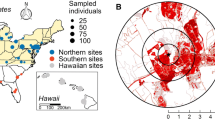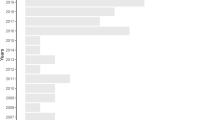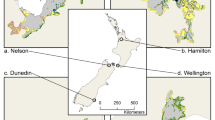Abstract
Context
Infectious diseases are important in the dynamics of many wildlife populations, but there is limited understanding of how landscape change influences susceptibility to disease.
Objectives
We aimed to quantify the time-delayed influence of spatial and temporal components of landscape change and climate variability on the prevalence of chlamydiosis in koala (Phascolarctos cinereus) populations in southeast Queensland, Australia.
Methods
We used data collected over 14 years (n = 9078 records) from a koala hospital along with time-lagged measures of landscape change and rainfall to conduct spatial and temporal analyses of the influence of landscape and environmental variables on prevalence of chlamydiosis and koala body condition.
Results
Areas with more suitable habitat were associated with higher levels of disease prevalence and better body condition, indicating that koalas were less likely to be impacted by chlamydiosis. More intact landscapes with higher proportions of total habitat are associated with a reduction in prevalence of chlamydiosis and a decrease in body condition. Increased annual rainfall contributed to a decrease in prevalence of chlamydiosis and an increase in body condition. Urbanization was associated with an increase in disease, however the effects of urban landscape change and climate variability on chlamydiosis may not manifest until several years later when overt disease impacts the population via effects upon body condition and reproductive success.
Conclusions
Our study highlights the importance of effects of landscape change and climate variability on disease prevalence in wildlife. This recognition is essential for long-term conservation planning, especially as disease often interacts with other threats.






Similar content being viewed by others
References
Adams-Hosking C, McBride MF, Baxter G, Burgman M, de Villiers D, Kavanagh R, Lawler I, Lunney D, Melzer A, Menkhorst P, Molsher R, Moore BD, Phalen D, Rhodes JR, Todd C, Desley W, McAlpine CA (2016) Use of expert knowledge to elicit population trends for the koala (Phascolarctos cinereus). Div Distrib 22:249–262
Ahlering MA, Millspaugh JJ, Woods RJ, Western D, Eggert LS (2011) Elevated levels of stress hormones in crop-raiding male elephants. Anim Conserv 14:124–130
Bairagi N, Roy PK, Chattopadhyay J (2007) Role of infection on the stability of a predator-prey system with several response functions—a comparative study. J Theor Biol 248:10–25
Blaustein AR, Gervasi SS, Johnson PTJ, Hoverman JT, Belden LK, Bradley PW, Xie GY (2012) Ecophysiology meets conservation: understanding the role of disease in amphibian population declines. Philos Trans R Soc B 367:1688–1707
Booth GD, Niccolucci MJ, Schuster EG (1994) Identifying proxy sets in multiple linear regression: an aid to better coefficient interpretation. Research paper INT-470. United States Department of Agriculture, Forest Service, Ogden, USA
Brearley G, McAlpine C, Bell S, Bradley A (2012) Influence of contrasting urban edges on arboreal mammal stress: a case study of squirrel gliders in southeast Queensland, Australia. Landscape Ecol 27:1407–1419
Brearley G, Rhodes JR, Bradley A, Baxter GS, Seabrook L, Lunney D, Liu Y, McAlpine C (2013) Wildlife disease prevalence in human-modified landscapes: a review. Biol Rev 88:427–442
Burnham KP, Anderson DR (2002) Model selection and multi-model inference: a practical information-theoretic approach, 2nd edn. Springer, New York
Carrick FN, Girjes AA, Melzer A, Ellis WA (1990) Prevalence of chlamydial infection in a relatively undisturbed koala population. In: Gordon G (ed) Koalas. Research for management. Proceedings of the Brisbane Koala Symposium, 22–23 Sep 1990, Brisbane
Chapman CA, Gillespie TR, Goldberg TL (2005) Primates and the ecology of their infectious diseases: how will anthropogenic change affect host–parasite interactions? Evol Anthropol 14:134–144
Chapman CA, Speirs ML, Gillespie TR, Holland T, Austad KM (2006) Life on the edge: gastrointestinal parasites from the forest edge and interior primate groups. Am J Primatol 68:397–409
Chasar A, Loiseau C, Valkiunas G, Iezhova T, Smith TB, Sehgal RNM (2009) Prevalence and diversity patterns of avian blood parasites in degraded African rainforest habitats. Mol Ecol 18:4121–4133
Clark RW, Marchand MN, Clifford BJ, Stechert R, Stephens S (2011) Decline of an isolated timber rattlesnake (Crotalus horridus) population: interactions between climate change, disease, and loss of genetic diversity. Biol Conserv 144:886–891
Cottontail VM, Wellinghausen N, Kalko EKV (2009) Habitat fragmentation and haemoparasites in the common fruit bat, Artibeus jamaicensis (Phyllostomidae) in a tropical lowland forest in Panama. Parasitology 136:1133–1145
Crowther MS, Lunney D, Lemon J, Stalenberg E, Wheeler R, Madani G, Ross KA, Ellis M (2014) Climate-mediated habitat selection in an arboreal folivore. Ecography 37:336–343
de Castro F, Bolker B (2005) Mechanisms of disease-induced extinction. Ecol Lett 8:117–126
de Oliveira SM, Murray PJ, de Villiers DL, Baxter GS (2013) Ecology and movement of urban koalas adjacent to linear infrastructure in coastal south-east Queensland. Aust Mammal 36:45–54
Dique DS, Thompson J, Preece HJ, de Villiers DL, Carrick FN (2003a) Dispersal patterns in a regional koala population in south-east Queensland. Wildl Res 30:281–290
Dique DS, Thompson J, Preece HJ, Penfold GC, de Villiers DL, Leslie RS (2003b) Koala mortality on roads in south-east Queensland: the koala speed-zone trial. Wildl Res 30:419–426
Dudaniec RY, Rhodes J, Worthington Wilmer J, Lyons M, Lee K, McAlpine C, Carrick F (2013) Using multi-level models to identify drivers of landscape genetic structure among management areas. Mol Ecol 22:3752–3765
Ellis WAH, Girjes AA, Carrick FN, Melzer A (1993) Chlamydial infections in koalas under relatively little alienation pressure. Aust Vet J 70:427–428
Engle RF (ed) (1984) Wald, likelihood ratio, and Lagrange multiplier tests in Econometrics. Elsevier Science Publishers B.V, Amsterdam
Evans KL, Gaston KJ, Sharp SP, McGowan A, Simeoni M, Hatchwell BJ (2009) Effects of urbanisation on disease prevalence and age structure in blackbird Turdus merula populations. Oikos 118:774–782
Fahrig L (2003) Effects of habitat fragmentation on biodiversity. Annu Rev Ecol Evol Syst 34:487–515
Fischer C, Reperant LA, Weber JM, Hegglin D, Deplazes P (2005) Echinococcus multilocularis infections of rural, residential and urban foxes (Vulpes vulpes) in the canton of Geneva, Switzerland. Parasite 12:339–346
Friggens MM, Beier P (2010) Anthropogenic disturbance and the risk of flea-borne disease transmission. Oecologia 164:809–820
Folstad I, Karter AJ (1992) Parasites, bright males and the immunocompetence handicap. Am Nat 139(3):603–622
Geue D, Partecke J (2008) Reduced parasite infestation in urban Eurasian blackbirds (Turdus merula): a factor favoring urbanization? Can J Zool 86:1419–1425
Gibbs SEJ, Wimberly MC, Madden M, Masour J, Yabsley MJ, Stallknecht DE (2006) Factors affecting the geographic distribution of West Nile virus in Georgia, USA: 2002–2004. Vector-borne Zoonotic 6:73–82
Gillespie TR, Chapman CA (2008) Forest fragmentation, the decline of an endangered primate, and changes in host-parasite interactions relative to an unfragmented forest. Am J Primatol 70:222–230
Girjes AA, Hugall AF, Timms P, Lavin MF (1988) Two distinct forms of Chlamydia psittaci associated with disease and infertility in Phascolarctos cinereus (koala). Infect Immun 56:1897–1900
Gordon G, Brown AS, Pulsford T (1988) A koala (Phascolarctos-cinereus Goldfuss) population crash during drought and heat-wave conditions in southwestern Queensland. Aust J Ecol 13:451–461
Gordon G, McGreevy DG, Lawrie BC (1990) Koala populations in Queensland—major limiting factors. In: Lee AK, Handasyde KA, Sanson GD (eds) Biology of the Koala. Surrey Beatty & Sons, Sydney, pp 75–84
Griffith JE (2010) Studies into the diagnosis, treatment and management of chlamydiosis in koalas. PhD thesis, The University of Sydney, Sydney, New South Wales
Grueber CE, Peel E, Gooley R, Belov K (2016) Genomic insights into a contagious cancer in Tasmanian devils. Trends Genet 31:528–535
Halekoh U, Højsgaard S, Yan J (2006) The R package geepack for generalized estimating equations. J Stat Softw 15:1–11
Hanger JJ, Bromham LD, McKee JJ, O’Brien TM, Robinson WF (2000) The nucleotide sequence of koala (Phascolarctos cinereus) retrovirus: a novel type C endogenous virus related to gibbon ape leukemia virus. J Virol 74:4264–4272
Harvell D, Altizer S, Cattadori IM, Harrington L, Weil E (2009) Climate change and wildlife diseases: when does the host matter the most? Ecology 90:912–920
Hennessy K, Fitzharris B, Bates BC, Harvey N, Howden SM, Hughes L, Salinger J, Warrick R (2007) Australia and New Zealand. Climate change 2007: impacts, adaptation and vulnerability. In: Parry ML, Canziani OF, Palutikof JP, van der Linden PJ, Hanson CE (eds) Contribution of working group II to the fourth assessment report of the intergovernmental panel on climate change. Cambridge University Press, Cambridge, pp 507–540
Holmes JC (1996) Parasites as threats to biodiversity in shrinking ecosystems. Biodivers Conserv 5:975–983
Hume ID (1990) Biological basis for the vulnerability of koalas to habitat fragmentation. In: Lunney D, Urquhart CA, Reed P (eds) Koala summit, managing Koalas in New South Wales. NSW National Parks and Wildlife Service, Hurstville, pp 32–35
Isaksson C (2015) Urbanisation, oxidative stress and inflammation: a question of evolving, acclimatizing or coping with urban environmental stress. Funct Ecol. doi:10.1111/1365-2435.12477
Jackson M, White N, Giffard P, Timms P (1999) Epizootiology of Chlamydia infections in two free-range koala populations. Vet Microbiol 65:225–234
Johnstone CP, Lill A, Reina RD (2011) Response of the agile antechinus to habitat edge, configuration and condition in fragmented forest. PLoS ONE 6:1–15
Johnstone CP, Lill A, Reina RD (2012) Does habitat fragmentation cause stress in the agile antechinus? A haematological approach. J Comp Physiol B 182:139–155
Klein SL (2000) The effects of hormones on sex differences in infection: from genes to behavior. Neurosci Biobehav Rev 24(6):627–638
Kollipara A, Polkinghorne A, Wan C, Kanyoka P, Hanger J, Loader J, Callaghan J, Bell A, Ellis W, Fitzgibbon S, Melzer A, Beagley K, Timms P (2013) Genetic diversity of Chlamydia pecorum strains in wild koala locations across Australia and the implications for a recombinant C. pecorum major outer membrane protein based vaccine. Vet Microbiol 167:513–522
Lafferty KD, Holt RD (2003) How should environmental stress affect the population dynamics of disease? Ecol Lett 6:654–664
Lane KE, Holley C, Hollocher H, Fuentes A (2011) The anthropogenic environment lessens the intensity and prevalence of gastrointestinal parasites in Balinese long-tailed macaques (Macaca fascicularis). Primates 52:117–128
Larsen S, Vaughan IP, Ormerod SJ (2009) Scale-dependent effect of fine sediments on temperate headwater invertebrates. Freshw Biol 54:203–219
Lehrer EW, Fredebaugh SL, Schooley RL, Mateus-Pinilla NE (2010) Prevalence of antibodies to toxoplasma gondii in woodchucks across an urban–rural gradient. J Wildl Dis 46:977–980
Liang KY, Zeger S (1986) Longitudinal data analysis using generalized linear models. Biometrika 73:13–22
Lunney D, Crowther MS, Wallis I, Foley WJ, Lemon J, Wheeler R, Madani G, Orscheg C, Griffith JE, Krockenberger M, Retamales M, Stalenberg E (2012) Koalas and climate change: a case study on the Liverpool plains, north-west NSW. In: Lunney D, Hutchings P (eds) Wildlife and climate change: towards robust conservation strategies for Australian fauna. Royal Zoological Society of NSW, Mosman, pp 150–168
Lunney D, Gresser S, O’Neill LE, Mathews A, Rhodes JR (2007) The impact of fire and dogs on koalas at Port Stephens, New South Wales, using population viability analysis. Pac Conserv Biol 13:189–201
Lunney D, Jones M, McCallum H (2008) Lessons from the looming extinction of the Tasmanian Devil. Guest editorial. Pac Conserv Biol 14:263–266
Lunney D, Stalenberg E, Santika T, Rhodes JR (2014) Extinction in Eden: identifying the role of climate change in the decline of the koala in south-eastern NSW. Wildl Res 41:22–34
Lunney D, Wells A, Miller I (2016) An ecological history of the Koala in Coffs Harbour and its environs, on the mid-north coast of New South Wales, c1861–2000. Proc Linn Soc NSW 138:1–48
Lyons MB, Phinn SR, Roelfsema CM (2012) Long term land cover and seagrass mapping using landsat and object-based image analysis from 1972 to 2010 in the coastal environment of South East Queensland, Australia. ISPRS J Photogramm 71:34–46
MacPhee RDE, Greenwood AD (2013) Infectious disease endangerment, and extinction. Int J Evol Biol 2013:1–9
Martin LB (2009) Stress and immunity in wild vertebrates: timing is everything. Gen Comp Endocr 163:70–76
Martin R, Handasyde K (1999) The koala: natural history, conservation and management, 2nd edn. University of NSW Press, Kensington
Matthews A, Lunney D, Gresser S, Maitz W (2016) Movement patterns of koalas in remnant forest after fire. Aust Mammal. doi:10.1071/AM14010
McAlpine CA, Bowen ME, Callaghan JG, Lunney D, Rhodes JR, Mitchell DL, Pullar DV, Possingham HP (2006a) Testing alternative models for the conservation of koalas in fragmented rural–urban landscapes. Aust Ecol 31:529–544
McAlpine CA, Rhodes JR, Callaghan JG, Bowen ME, Lunney D, Mitchell DL, Pullar DV, Possingham HP (2006b) The importance of forest area and configuration relative to local habitat factors for conserving forest mammals: a case study of koalas in Queensland, Australia. Biol Conserv 132:153–165
McAlpine C, Lunney D, Melzer A, Menkhorst P, Phillips S, Phalen D, Ellis W, Foley W, Baxter G, de Villiers D (2015) Conserving koalas: a review of the contrasting regional trends, outlooks and policy challenges. Biol Conserv 192:226–236
McAlpine CA, Syktus JI, Ryan JG, Deo RC, McKeon GM, McGowan HA, Phinn SR (2009) A continent under stress: interactions, feedbacks and risks associated with impact of modified land cover on Australia’s climate. Glob Change Biol 15:2206–2223
McCallum H, Dobson A (1995) Detecting disease and parasite threats to endangered species and ecosystems. Trends Ecol Evol 10:190–194
Melzer A, Carrick F, Menkhorst P, Lunney D, John BS (2000) Overview, critical assessment, and conservation implications of koala distribution and abundance. Conserv Biol 14:619–628
Melzer A, Houston W (2001) An overview of the understanding of koala ecology: how much more do we need to know? In: Lyons K, Melzer A, Carrick F, Lamb D (eds) The research and management of non-urban koala populations. Central Queensland University, Rockhampton, pp 6–45
Moilanen A, Nieminen M (2002) Simple connectivity measures in spatial ecology. Ecology 83:1131–1145
Moore BD, Foley WJ (2000) A review of feeding and diet selection in koalas (Phascolarctos cinereus). Aust J Zool 48:317–333
Moore BD, Foley WJ (2005) Tree use by koalas in a chemically complex landscape. Nature 435:488–490
Narayan EJ, Williams M (2016) Understanding the dynamics of physiological impacts of environmental stressors on Australian marsupials, focus on the koala (Phascolarctos cinereus). BMC Zool 1(1):2
Phillips SS (2000) Population trends and the koala conservation debate. Conserv Biol 14:650–659
Plowright RK, Sokolow SH, Gorman ME, Daszak P, Foley JE (2008) Causal inference in disease ecology: investigating ecological drivers of disease emergence. Front Ecol Environ 6:420–429
Polkinghorne A, Hanger J, Timms P (2013) Recent advances in understanding the biology, epidemiology and control of chlamydial infections in koalas. Vet Microbiol 165:214–223
Preece HJ (2007) Monitoring and modelling threats to koala populations in rapidly urbanising landscapes: Koala coast, south east Queensland, Australia. PhD thesis, School of Geography, Planning and Architecture, University of Queensland. doi:10.14264/uql.2015.742
Queensland Government (2011) Silo climate data. Queensland Governments “The Long Paddock”. http://www.longpaddock.qld.gov.au/silo/ppd/index.php
Queensland Herbarium (2011) Regional ecosystem description database (REDD) version 6.0b—January 2011. Department of Environment and Resource Management: Brisbane
Rhodes JR, Beyer HL, Preece HJ, McAlpine CA (2015) South East Queensland Koala population modelling study. UniQuest, Brisbane
Rhodes JR, Ng CF, de Villiers DL, Preece HJ, McAlpine CA, Possingham HP (2011) Using integrated population modelling to quantify the implications of multiple threatening processes for a rapidly declining population. Biol Conserv 144:1081–1088
Rhodes JR, Wiegand T, McAlpine CA, Callaghan J, Lunney D, Bowen M, Possingham HP (2006) Modeling species’ distributions to improve conservation in semiurban landscapes: koala case study. Conserv Biol 20:449–459
Salzer JS, Rwego IB, Goldberg TL, Kuhlenschmidt MS, Gillespie TR (2007) Giardia sp. and Cryptosporidium sp. infections in primates in fragmented and undisturbed forest in western Uganda. J Parasitol 93:439–440
Santamaria F, Schlagloth RJ (2016) The effect of Chlamydia on translocated Chlamydia-naïve koalas: a case study. Aust Zool. doi:10.7882/AZ.2016.025
Santika T, McAlpine CA, Lunney D, Wilson KA, Rhodes JR, Thuiller W (2014) Modelling species distributional shifts across broad spatial extents by linking dynamic occupancy models with public-based surveys. Divers Distrib 20:786–796
Simmons GS, Young PR, Hanger JJ, Jones K, Clarke D, McKeed JJ, Meersa J (2012) Prevalence of koala retrovirus in geographically diverse populations in Australia. Aust Vet J 90(10):404–409
Smith KF, Acevedo-Whitehouse K, Pedersen AB (2009) The role of infectious diseases in biological conservation. Anim Conserv 12:1–12
Su M, Li WL, Li ZZ, Zhang FP, Hui C (2009) The effect of landscape heterogeneity on host-parasite dynamics. Ecol Res 24:889–896
Thompson J (2006) The comparative ecology and population dynamics of koalas in the Koala Coast region of south-east Queensland. PhD thesis, The University of Queensland
Tilman D, May RM, Lehman CL, Nowak MA (1994) Habitat destruction and the extinction debt. Nature 371:65–66
Walsh JF, Molyneux DH, Birley MH (1993) Deforestation—effects on vector-borne disease. Parasitology 106:S55–S75
Waugh C, Khan SA, Carve S, Hanger J, Loader J, Polkinghorne A, Beagley K, Timms P (2016) A prototype recombinant-protein based Chlamydia pecorum vaccine results in reduced chlamydial burden and less clinical disease in free-ranging koalas (Phascolarctos cinereus). PLoS ONE. doi:10.1371/journal.pone.0146934
Weigler B, Girjes A, White N, Kunst N, Carrick F, Lavin M (1988) Aspects of the epidemiology of Chlamydia psittaci infection in a population of koalas (Phascolarctos cinereus) in Southeastern Queensland, Australia. J Wildl Dis 24:282–291
Wright A, Gompper M (2005) Altered parasite assemblages in raccoons in response to manipulated resource availability. Oecologia 144:148–156
Zorn CJW (2001) Generalized estimating equation models for correlated data: a review with applications. Am J Polit Sci 45:470–490
Zuur AF, Ieno EN, Walker NJ, Saveliev AA, Smith GM (2009) Mixed effects models and extensions in ecology with R. Springer Science + Business Media, LLC, New York
Acknowledgements
We gratefully acknowledge the Queensland Department of Environment and Heritage Protection for funding this study. Many thanks to Hawthorne Beyer, Harriet Preece and Chris Moon for their comments and edits. The input of three anonymous reviewers greatly improved the quality of the manuscript.
Author information
Authors and Affiliations
Corresponding author
Electronic supplementary material
Below is the link to the electronic supplementary material.
Rights and permissions
About this article
Cite this article
McAlpine, C., Brearley, G., Rhodes, J. et al. Time-delayed influence of urban landscape change on the susceptibility of koalas to chlamydiosis. Landscape Ecol 32, 663–679 (2017). https://doi.org/10.1007/s10980-016-0479-2
Received:
Accepted:
Published:
Issue Date:
DOI: https://doi.org/10.1007/s10980-016-0479-2




